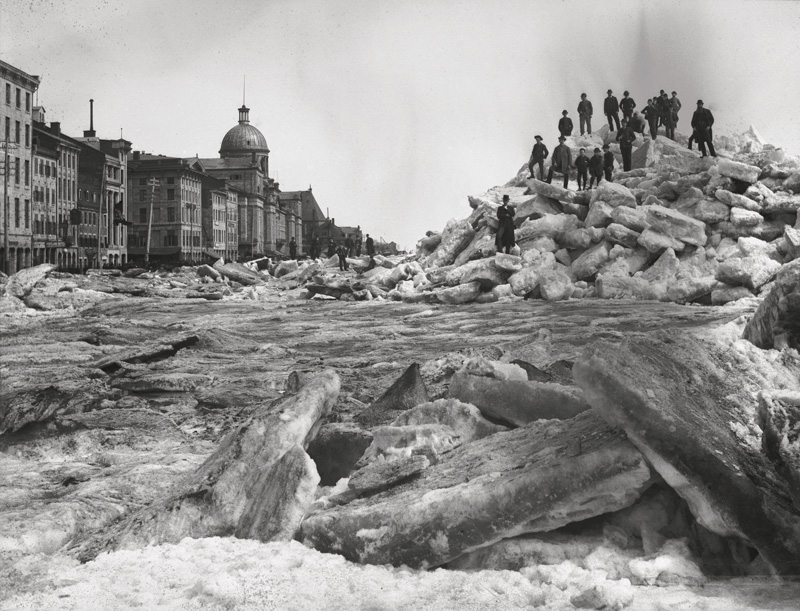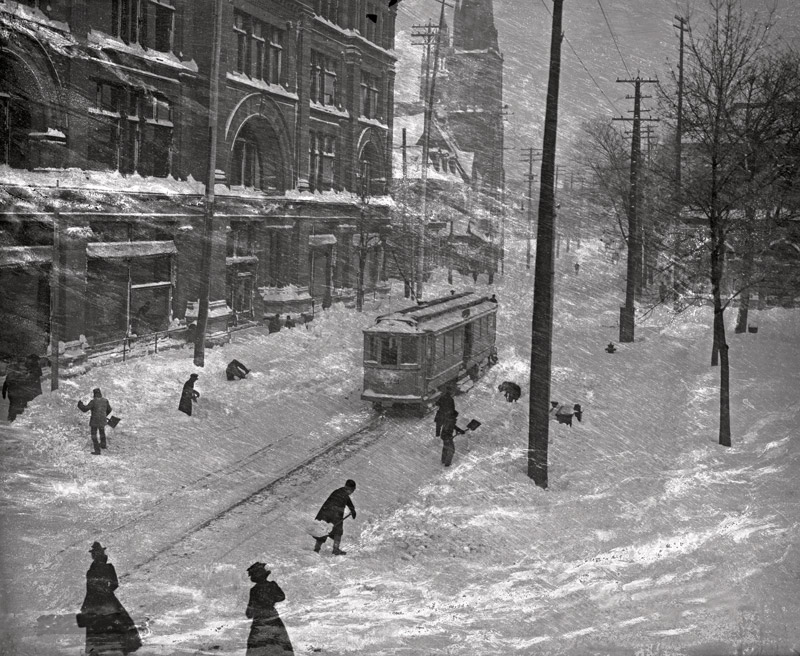[Winter 2017]
Hélène Samson has been the curator of the photography collection at the McCord Museum since 2006. She is interested in collecting vernacular Canadian photographs and updating nineteenth-century photographic archives. She has just edited a book produced by the McCord Museum and Éditions Hazan (Paris) on the work of Canadian photographer William Notman (1826–91), as a complement to the exhibition Notman, a Visionary Photographer, presented at the McCord Museum from November 4, 2016, to March 26 2017.
An interview by Jacques Doyon
JD: What is the importance of the Notman archive – its nature and scope? What have been the major steps in inventorying and displaying it since it was received by the McCord Museum in 1956?
HS: The photographic archive from 1856 to 1935 of the Notman studio in Montreal was acquired by McGill University in 1956 as an endowment for the McCord Museum. The actual archive is composed, among other things, of 200,000 negatives on glass plates, 188 picture books, and various documents very rich in historical information, such as index books and payroll registers. It is estimated that there are 450,000 different photographs, 80% of which are identified portraits. That said, today we speak of a Notman Collection, as we continue to acquire photographs and objects related to William Notman and his business. Since this major acquisition, numerous donations by the photographer’s descendants and by collectors have greatly enriched the collection. For example, Skating Carnival (1870), the famous composite photograph coloured in oils that portrays almost 150 people at the Victoria skating rink, was a gift from Geoffrey Notman, William Notman’s grandson, in 1965. Similarly, family correspondence, administrative papers, and a plethora of photographs conserved by the Notman family have been offered to the McCord Museum in recent decades….
I see two major stages in the exploration of this collection. The first was the huge amount of work done by Stanley Triggs, curator from 1965 to 1993; for thirty years, he studied the studio’s archives and published his research. He wrote the remarkable book Portrait of a Period (1967), which brought an extraordinary body of work into the public view. His work went hand in hand with that of Nora Hague, who was the main cataloguer of negatives and prints from 1965 to 2015. The second stage was the vast undertaking of the digital catalogue and the digitization of photographs under the direction of Nicole Vallières in the 1980s and 1990s. This project is ongoing today.
JD: Notman, a Visionary Photographer is being presented as the first retrospective exhibition of his work. How important is this project? Why has such a retrospective not been possible up to now?
HS: This first retrospective of Notman’s work makes it possible for neophytes to discover the entire range of his oeuvre and to see what he left for posterity. It also fills out the picture for those who had heard about him but had only a vague idea about what he did. Previous exhibitions, such as the one in 1994 on the composite photographs, were intended more for the public who already knew his work. For those people, this exhibition provides an opportunity to review their knowledge and to see all of the work through the lens of modernity.
As an assessment, if I can put it that way, this exhibition is based on years of analysis of Notman’s work. I returned to Triggs’s biographical research and to that of scholars who took deeper looks at certain aspects, such as stereography, documentation of the Victoria Bridge, the Maple Box portfolios offered to Queen Victoria, and the classification of photographs. Over my ten years of work at McCord museum, I have stood on the shoulders of these researchers. The synthesis could have been made only after accumulating detailed knowledge of the complete body of work. In addition, the massive digitization operation performed during the 1990s, which provided a sampling of a large part of the studio’s production, proved to be a an essential factor in this overview.
JD: How long has this project being underway? What were the major steps in its development? How has Montreal’s 375th anniversary offered an opportunity to produce such an exhibition?
HS: The decision to produce a major exhibition on Notman was made in November 2012, with an opening planned for May 2015. The early plan was to have the exhibition tour and to publish a comprehensive book. We started with an intense period of immersing ourselves in the collection and discussing of all sorts of ideas. Curator Bill Ewing was involved at this stage. He had previously approached me in 2007, when he was director of the Musée de l’Élysée in Lausanne, to have a Notman show in his museum in Switzerland. With his experience as a photography curator on the international scene, Bill provided a valuable contribution at the beginning of the project. By the end of this stage, we had decided on the notion of modernity. Then, without going into detail, the major steps were the scenario, the exhibition design by Mélanie Crespin, restoration, and production – that is, the last step, framing and installation. The exhibition and the book were developed together.
In March 2013, we pushed the schedule for these projects to late 2016, so that they would be in place to celebrate the beginning of 2017. It seemed obvious that this Montreal photographer was an ideal figure for celebration of the city’s 375th anniversary, as well as the 150th anniversary of Canadian Confederation. Notman literally put together the “family album” of Montrealers of the second half of the nineteenth century, a period when the city was burgeoning and the plan for Canadian Confederation was achieved. Notman provided a visual memory of both the city and the country at these historic stages.
JD: What were the main museographic objectives for the exhibition? What challenges did they involve, particularly with regard to selection and display of images and objects?
HS: Certain museographic objectives took priority from the beginning of the project: the period prints on albumen paper, relating the photographer’s career precisely and accurately, and, above all, not re-creating a nineteenth-century ambience. In other words, we wanted to show Notman as a contemporary photographer. This last objective led us to use visual mechanisms from our times to highlight the variety and quality of the images. The period prints and negatives sit alongside backlit enlargements, projections, film clips, and interactive catalogues.
When you have 450,000 photographs, of course, selection can be a problem. It was impossible to have exhaustive knowledge of this collection. That is why we started from analyses already performed and took advantage of about 100,000 digitized photographs that sample the collection as a whole. Fortunately, there is much repetition, especially in the portraits. Nevertheless, I wanted to depart from the canon of Notman photographs contained in Portrait of a Period and show new portraits, highlighting less well-known landscapes.
The material condition of the “vintages” complicated the making of the exhibition, as the vast majority of photographs are negatives on glass or prints glued into photo albums. Often, the secondary support for the prints was damaged and warped. Many of the photographs that I wanted to show were glued with a number of others onto a single support. So, we had to find a way to frame this photograph and hide the others. Our technicians had to use every trick in the book to deal with such conditions. Most of the albums and objects required very specialized restoration.
JD: The exhibition was organized around four themes aiming to offer a fresh vision of William Notman’s modernity. How was Notman a sort of precursor to the history of Montreal and Canadian photography?
HS: I developed a preliminary scenario from the material in the collection while wanting to show Notman’s modern vision. This version was expressed in themes that describe his body of work: Montreal, the portrait studio, the artistic vision, the business, distribution, and so on. When I reviewed this proposition with the scenario writer, Geneviève Murray, we reconfigured the scenario according to the great personal qualities that made Notman a visionary: the bold businessman, the networker, the artist, and the builder. Through these four themes, I was able to tell Notman’s story and that of his company while bringing out his modern aspect, which was that he had an avant-garde vision for his times. He used methods such as stereography, retouching, collage, virtual scenes, performative portraits, and publication – all indications that he grasped the unusual potential of the new medium, including the multiplication and manipulation of images. In addition, Notman’s practice prefigured today’s conditions of image making: a cohabitation of commerce, communications, and artistic sensibilities.
JD: The exhibition is accompanied by a major book comprising seven essays, co-published with Hazan and distributed by Yale University Press. How do these essays specifically highlight the importance of Notman’s contribution to Canadian photography?
HS: The book is intended to be a beautiful book of photographs to contemplate and a reference containing the latest knowledge on Notman. The authors, who were commissioned to write their chapters, offer a thorough discussion of aspects of his work and provide new information. Topics include his artistic vision, his contribution to the development of the photomechanical procedure known as halftone, and his publications and their national cultural impact. In her essay, Sarah Parsons looks at the studio portraits from a very contemporary point of view. I’m particularly happy about the contribution by Nora Hague, who, after forty-seven years of work on the Notman Collection, explains the system of classification and indexation of photographs at the Montreal studio. This knowledge, previously transmitted orally to a few initiates, is now accessible to everyone. In addition, the history of the acquisition of the Notman archive by McGill University and its development into a collection at the McCord Museum have been revisited and detailed by Heather McNabb.
JD: And perhaps, to wrap up, can you tell us a little about future projects that will continue to highlight the Notman bequest?
HS: The exhibition Notman, a Visionary Photographer will be presented at the Glenbow Museum in Calgary and the Canadian Museum of History in Gatineau in 2018 and 2019, respectively. Other destinations in Canada and the United States are awaiting confirmation. Following the redesign of the McCord Museum’s website, we are planning to offer a version of the exhibition on the Google Art Project site.
Jacques Doyon is director and editor-in-chief of Ciel variable.




